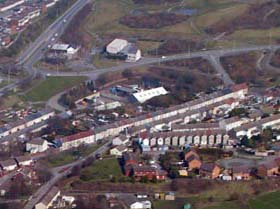Historic Landscape
Characterisation
Merthyr Tydfil
004 Penydarren Iron Works Area
HLCA 004 Penydarren Iron Works Area Early ironworks
area with remains of blast furnaces and adjacent area of late 19th / early
20th century industrial housing,' nationally and internationally important
historic, and technological associations; site of industrial transport
features and power generation.
Click here for a
character area map
Summary
Penydarren Iron Works were founded in 1784, but were in ruins by the 1870s. The area was later developed as the depot for the tramway system and as workers' housing. A few of the ironworks structures still survive, but otherwise the area is mainly characterised by industrial terraced housing.
Historical background
The historic landscape area of Penydarren Iron Works Area encompasses the main area of the ironworks founded in 1784 by Francis Homfray. In 1788, Penydarren was the second Merthyr ironworks to begin production of bar iron, buying in pig iron from Dowlais to keep up with demand. Late 18th century cartographic evidence (1799 Yates) depicts two blocks of Ironwork buildings and a "waggon way" which approached Pen-y-Darren Ironworks from the south from coalmines in HLCA 039. The works developed numerous trackways and tramways over the following period. The effect on the adjacent HLCA 040 was dramatic; by 1814 the area was already heavily quarried, and later maps chart the development. The Homfray family's association with the works ended with the death of Samuel Homfray in 1822. Thereafter the works continued under the partnership of Thompson and Foreman. The Penydarren iron works engaged in rail production at an early stage, supplying the Liverpool and Manchester Railway. However severely competitive markets of the 1850s caused increasing difficulties and production ceased in 1859, under Messers Fothergill and Hankey. The works and its associated vast mineral deposits were later sold to Dowlais for almost £60,000.
While cartographic sources indicate the Ironworks, including its blast furnaces, casting houses, and rail network remained in 1875-78, contemporary photographs show the works in ruins by this date. The area of ironworks was subsequently cleared and by 1919, the tramway depot and the electric power station of the Merthyr Electric Traction and Lighting Co. occupied the furnace area. The western part of the ironworks was later redeveloped for housing; by 1905 the southern side and part of the northern side of Trevithick Street and a short row at Gwynnes Close were in place, and completed by 1919. The cartographic evidence also showed a short row dating from before 1850, opposite the entrance to Pen-y-Darren Park.
